Coupled DSSAT and HYDRUS-1D Simulation of the Farmland–Crop Water Cycling Process in the Dengkouyangshui Irrigation District
Abstract
1. Introduction
2. Materials and Methods
2.1. Study Area Overview
2.2. Experimental Design and Data Collection
2.2.1. Soil Physical Properties of the Study Area
2.2.2. Meteorological Data Collection
2.2.3. Crop Growing Season
2.2.4. Groundwater Depth
2.3. DSSAT-HYDRUS-1D Coupled Model
2.3.1. DSSAT Model
2.3.2. HYDRUS-1D Model
2.3.3. DSSAT-HYDRUS-1D Coupled Model
2.4. Model Establishment, Calibration, and Validation
2.4.1. Division of Simulation Units in the Study Area
2.4.2. Initial and Boundary Conditions
2.4.3. Soil Parameters
2.4.4. Model Calibration and Validation
3. Results
3.1. Model Calibration
3.2. Model Validation
3.3. Soil Moisture Dynamics
3.4. Impact of Soil Moisture Variation on Crop Growth
3.5. Analysis of Water Dynamics during Crop Growth Stages
4. Discussion
5. Conclusions
Author Contributions
Funding
Data Availability Statement
Acknowledgments
Conflicts of Interest
References
- Zhou, X.; Liao, J. Accelerating the development of lrrigated areas in Jjiangxi Province, suggestions on helping food production security. J. Irrig. Drain. 2022, 41, 115–118. [Google Scholar] [CrossRef]
- Ding, Y.; Zhou, C.; Shao, M.A.; Chen, Y.; Zhang, G.; Zhang, S.; Han, T.; Nan, Z. Studies of earth surface processes: Progress and prospect. Adv. Earth Sci. 2013, 28, 407–419. [Google Scholar]
- Jeyalakshmi, S.; Chilkoti, V.; Bolisetti, T.; Balachandar, R. Earth data assimilation in hydrologic models: Recent advances. Int. J. Environ. Stud. 2021, 78, 1003–1021. [Google Scholar] [CrossRef]
- Ackerer, J.; Kuppel, S.; Braud, I.; Pasquet, S.; Fovet, O.; Probst, A.; Pierret, M.-C.; Ruiz, L.; Tallec, T.; Lesparre, N. Exploring the Critical Zone Heterogeneity and the Hydrological Diversity Using an Integrated Ecohydrological Model in Three Contrasted Long-Term Observatories. Water Resour. Res. 2023, 59, e2023WR035672. [Google Scholar] [CrossRef]
- Yang, S.; Yu, J.; Lou, H.; Sun, W.; Zhao, C.; Wang, X.; Song, W.; Cai, M.; Dai, Y. Review of the remote sensing hydrological mode. Acta Geogr. Sin. 2023, 78, 1691–1702. [Google Scholar]
- Beven, K. How to make advances in hydrological modelling. Hydrol. Res. 2019, 50, 1481–1494. [Google Scholar] [CrossRef]
- Pei, Y.; Xu, J.; Xiao, W.; Yang, M.; Hou, B. Development and application of the water amount, quality and efficiency regulation model based on dualistic water cycle. J. Hydraul. Eng. 2020, 51, 1473–1485. [Google Scholar]
- Wang, Y. Evaluation of Farmland Water Circulation Health in Irrigated Area of North China Plain: A Case Study of Junliu Irrigated Area. Master’s Thesis, Hebei University of Engineering, Handan, China, 2021. [Google Scholar]
- Zhang, M. Study on Law of Hydrological Cycle and Water Resources Regulation in Jinghui Canal Irrigation District. Ph.D. Thesis, Chang’an University, Xi’an, China, 2021. [Google Scholar]
- Wang, R.; Xiong, L.; Xu, X.; Liu, S.; Feng, Z.; Wang, S.; Huang, Q.; Huang, G. Long-term responses of the water cycle to climate variability and human activities in a large arid irrigation district with shallow groundwater: Insights from agro-hydrological modeling. J. Hydrol. 2023, 626, 130264. [Google Scholar] [CrossRef]
- Gaagai, A.; Aouissi, H.A.; Krauklis, A.E.; Burlakovs, J.; Athamena, A.; Zekker, I.; Boudoukha, A.; Benaabidate, L.; Chenchouni, H. Modeling and Risk Analysis of Dam-Break Flooding in a Semi-Arid Montane Watershed: A Case Study of the Yabous Dam, Northeastern Algeria. Water 2022, 14, 767. [Google Scholar] [CrossRef]
- Gao, Z.; Zhong, R.; Yang, S. Recent progresses in research and applications of Hydrus model in China. Soils 2022, 54, 219–231. [Google Scholar]
- Yu, Q.; Liu, C. Research progress on the application of SWAT model in irrigation area. J. Irrig. Drain. 2015, 34, 281–284. [Google Scholar] [CrossRef]
- Yuan, C.; Feng, S. Simylation of soil water-salt flux of sunflower farmland in Hetao Lrrigation District based on SWAP model. J. Water Resour. Water Eng. 2023, 34, 19–27, 36. [Google Scholar]
- Shao, P.; Xiong, Y.; Yuan, N.; Peng, Z.; Li, Y.; Su, P.; Wei, G.; Ye, L.; Lin, X. Hydrological cycle for Paddy-Ponds-Ditches system and reuse of returnflow in Southern hilly irrigated areas. Trans. Chin. Soc. Agric. Eng. 2023, 39, 106–117. [Google Scholar] [CrossRef]
- Wang, G.; Shi, H.; Li, X.; Yan, J.; Miao, Q.; Chen, N.; Wang, W. Simulation and evaluation of soil water and salt transport in desert oases of Hetao Irrigation District using HYDRUS-1D model. Trans. Chin. Soc. Agric. Eng. 2021, 37, 87–98. [Google Scholar]
- Yu, J.; Wu, Y.; Xu, L.; Peng, J.; Chen, G.; Shen, X.; Lan, R.; Zhao, C.; Zhangzhong, L. Evaluating the Hydrus-1D Model Optimized by Remote Sensing Data for Soil Moisture Simulations in the Maize Root Zone. Remote Sens. 2022, 14, 6079. [Google Scholar] [CrossRef]
- Barman, L.; Prasad, R.K.; Sivakumar, B. Streamflow simulation using Soil and Water Assessment Tool (SWAT): Application to Periyar River basin in India. ISH J. Hydraul. Eng. 2023, 29, 332–345. [Google Scholar] [CrossRef]
- Li, Y. Study on Maize Yield Estimation Using Remote Sensing Technology Integrated with Coupled WOFOST and HYDRUS Models. Ph.D. Thesis, Lanzhou University, Lanzhou, China, 2012. [Google Scholar]
- Hao, Y.; Xu, X.; Ren, D.; Huang, Q.; Huang, G. Distributed modeling of soil water-salt dynamics and crop yields based on HYDRUS-EPIC model in Hetao Irrigation District. Trans. Chin. Soc. Agric. Eng. 2015, 31, 110–116. [Google Scholar]
- Wang, P.; Lu, Z.; Huo, Z. Distributed water transformation model based on multi-process coupling in rice irrigation area. J. Hydraul. Eng. 2021, 52, 1163–1173. [Google Scholar] [CrossRef]
- Wang, X.; Liu, G.; Yang, J.; Huang, G.; Yao, R. Evaluating the effects of irrigation water salinity on water movement, crop yield and water use efficiency by means of a coupled hydrologic/crop growth model. Agric. Water Manag. 2017, 185, 13–26. [Google Scholar] [CrossRef]
- Zhu, Y.; Tang, L.; Liu, L.; Liu, B.; Zhang, X.; Qiu, X.; Tian, Y.; Cao, W. Research progress on the crop growth model crop grow. Sci. Agric. Sin. 2021, 53, 3235–3256. [Google Scholar]
- Jones, J.W.; Hoogenboom, G.; Porter, C.H.; Boote, K.J.; Batchelor, W.D.; Hunt, L.A.; Wilkens, P.W.; Singh, U.; Gijsman, A.J.; Ritchie, J.T. The DSSAT cropping system model. Eur. J. Agron. 2003, 18, 235–265. [Google Scholar] [CrossRef]
- Wang, P. Research of Optimizing Deficit lrrigation for Sugarcane in Guangxi Province Using the DSSAT Model Based on Genetic Algorithm. Master’s Thesis, Hebei University of Engineering, Handan, China, 2022. [Google Scholar]
- Šimůnek, J.; Šejna, M.; Saito, H.; Sakai, M.; Van Genuchten, M.T. The HYDRUS-1D Software Package for Simulating the Movement of Water, Heat, and Multiple Solutes in Variably-Saturated Media; Version 4.08; University of California-Riverside: San Diego, CA, USA, 2009; pp. 1–240. [Google Scholar]
- van Genuchten, M.T. A Closed-form Equation for Predicting the Hydraulic Conductivity of Unsaturated Soils1. Soil Sci. Soc. Am. J. 1980, 44, 892–898. [Google Scholar] [CrossRef]
- Shelia, V.; Šimůnek, J.; Boote, K.; Hoogenbooom, G. Coupling DSSAT and HYDRUS-1D for simulations of soil water dynamics in the soil-plant-atmosphere system. J. Hydrol. Hydromech. 2018, 66, 232–245. [Google Scholar] [CrossRef]
- Ren, D.; Xu, X.; Hao, Y.; Huang, G. Modeling and assessing field irrigation water use in a canal system of Hetao, upper Yellow River basin: Application to maize, sunflower and watermelon. J. Hydrol. 2016, 532, 122–139. [Google Scholar] [CrossRef]
- Wang, W. Study on Management Model of Summer Maize Based onDSSAT and Assimilation of Remote Sensing. Master’s Thesis, Zhengzhou University, Zhengzhou, China, 2020. [Google Scholar]
- Miao, X.; Wang, G.; Li, R.; Xu, B.; Zheng, H.; Tian, D.; Wang, J.; Ren, J.; Li, Z.; Zhou, J. Study on Modeling and Evaluating Alfalfa Yield and Optimal Water Use Efficiency in the Agro-Pastoral Ecotone of Northern China. Plants 2024, 13, 229. [Google Scholar] [CrossRef] [PubMed]
- Ahirwar, S.; Subbaiah, R.; Gupta, P.; Tiwari, M.K.; Trivedi, M.M.; Vaishnav, P. Simulation of Maize Phenology and Grain Yield Using DSSAT Model. Int. J. Environ. Clim. Change 2023, 13, 2545–2556. [Google Scholar] [CrossRef]
- Li, L. Estimation of Root Zone Soil Moisture of Maize by Assimilating Remote Sensing Data. Ph.D. Thesis, University of Chinese Academy of Sciences, Beijing, China, 2022. [Google Scholar]
- Cheng, L.; Wu, B.; Jia, X.; Yin, J.; Fei, B.; Zhang, L.; Yue, Y.; Sun, Y.; Li, J. Dynamic change of soil moisture and its response to rainfall during the growing season in Mu Us SandyLand based on continyous observation data. Arid Land Geogr. 2024, 1–16. [Google Scholar]
- Liu, Q. Evaluation of the Impact of Spatial and Temporal Evolution of Drought on Maize Growth and Yield. Master’s Thesis, Northwest A&F University, Xianyang, China, 2022. [Google Scholar]
- Li, D. Study on the Restricting Factors and Promoting Ways of Irrigation Water Productivity in Heihe Oasis Based on Soil and Agronomic Measures. Ph.D. Thesis, China Agricultural University, Beijing, China, 2019. [Google Scholar]
- Wang, Y. Effects of Irrigation and Nitrogen Application on Winter Wheat-Summer Maize Yield and Water and Nitrogen Use Efficiency in North China. Master’s Thesis, Beijing Forestry University, Beijing, China, 2021. [Google Scholar]
- Feng, G.; Zhu, C.; Wu, Q.; Wang, C.; Zhang, Z.; Mwiya, R.M.; Zhang, L. Evaluating the impacts of saline water irrigation on soil water-salt and summer maize yield in subsurface drainage condition using coupled HYDRUS and EPIC model. Agric. Water Manag. 2021, 258, 107175. [Google Scholar] [CrossRef]
- Zhang, Y.-L.; Wang, F.-X.; Shock, C.C.; Yang, K.-J.; Kang, S.-Z.; Qin, J.-T.; Li, S.-E. Effects of plastic mulch on the radiative and thermal conditions and potato growth under drip irrigation in arid Northwest China. Soil Till. Res. 2017, 172, 1–11. [Google Scholar] [CrossRef]
- Fu, Y.; Li, Y.; Yu, H.; Wu, J.; Zhang, X. Effects of ridging and plastic film mulching on the water balance of summer maize during its growth period. Trans. Chin. Soc. Agric. Eng. 2023, 39, 76–87. [Google Scholar]
- Ren, D.; Xu, X.; Huang, G. Irrigation water use in typical irrigation and drainage system of Hetao Irrigation District. Trans. Chin. Soc. Agric. Eng. 2019, 35, 98–105. [Google Scholar]
- Chen, J. Simulation study of farmland water balance in arid area based on SHAW model. Water Resour. Plan. Design 2018, 81–84, 104. [Google Scholar] [CrossRef]
- Zhao, L.; Zhao, W. Water balance and migration for maize in an oasis farmland of northwest China. Chin. Sci. Bull. 2014, 59, 4829–4837. [Google Scholar] [CrossRef]
- Yang, D. Effects of Tillage Methods on Maize Growth and Soil Water Transport in the Field and Its Simulation. Master’s Thesis, Shenyang Agricultural University, Shenyang, China, 2022. [Google Scholar]
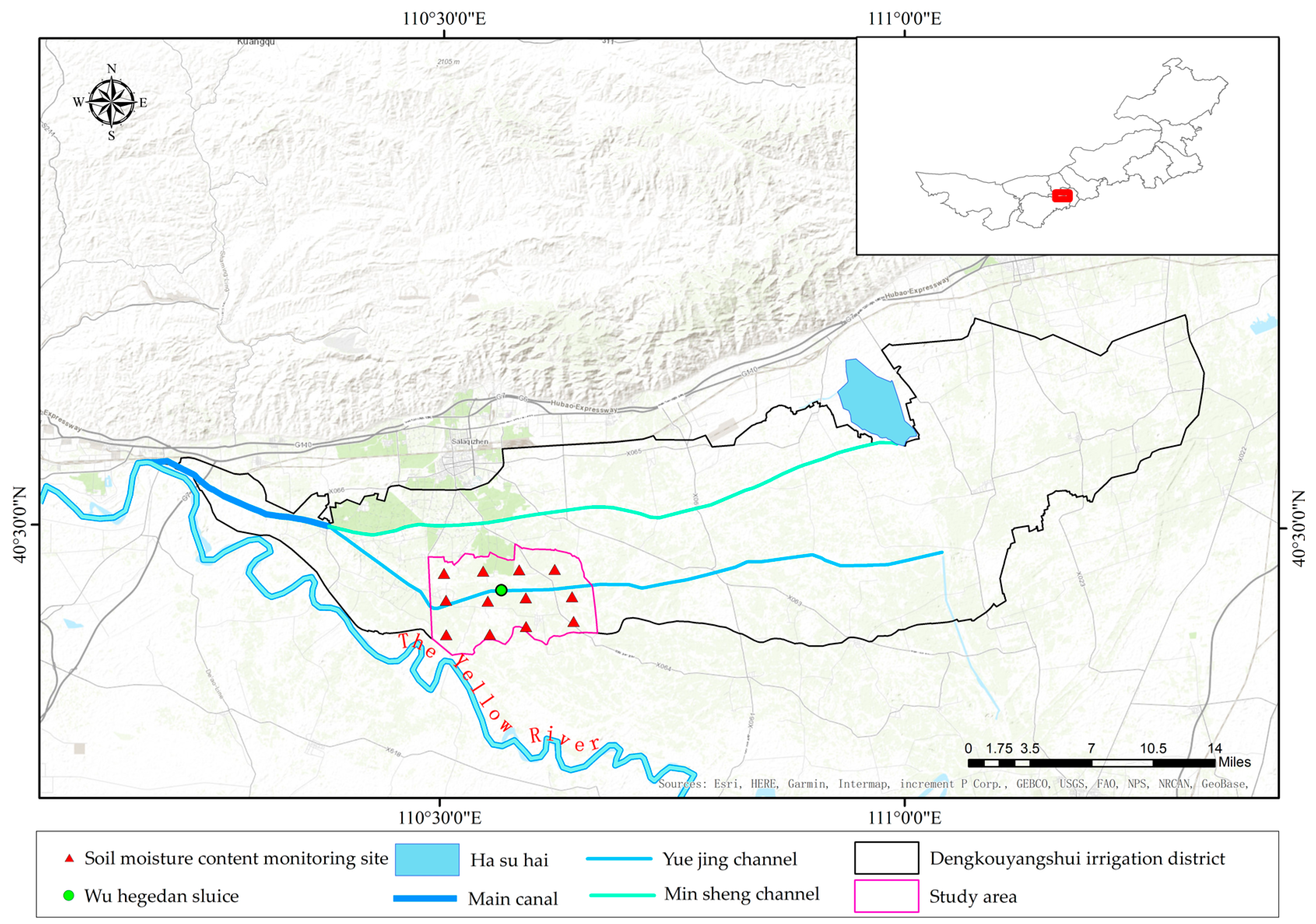
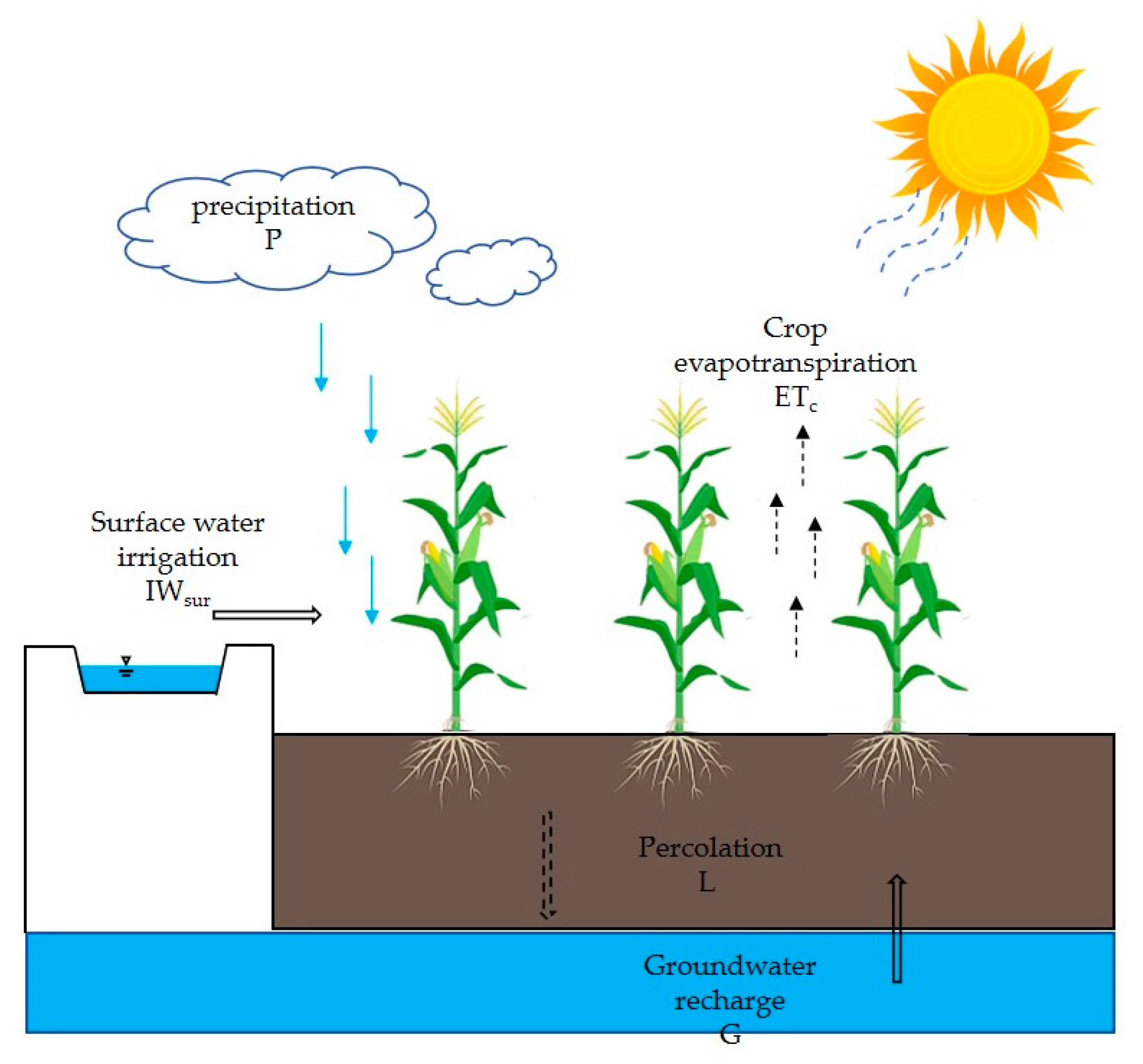
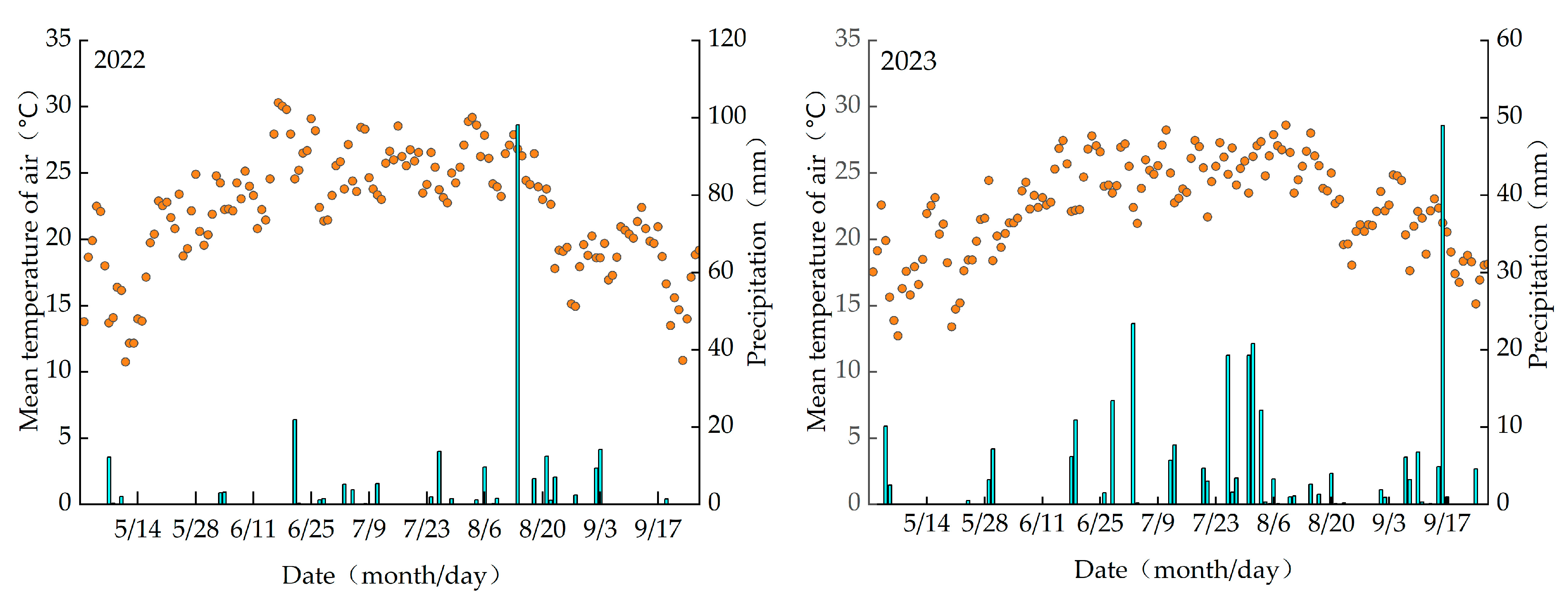
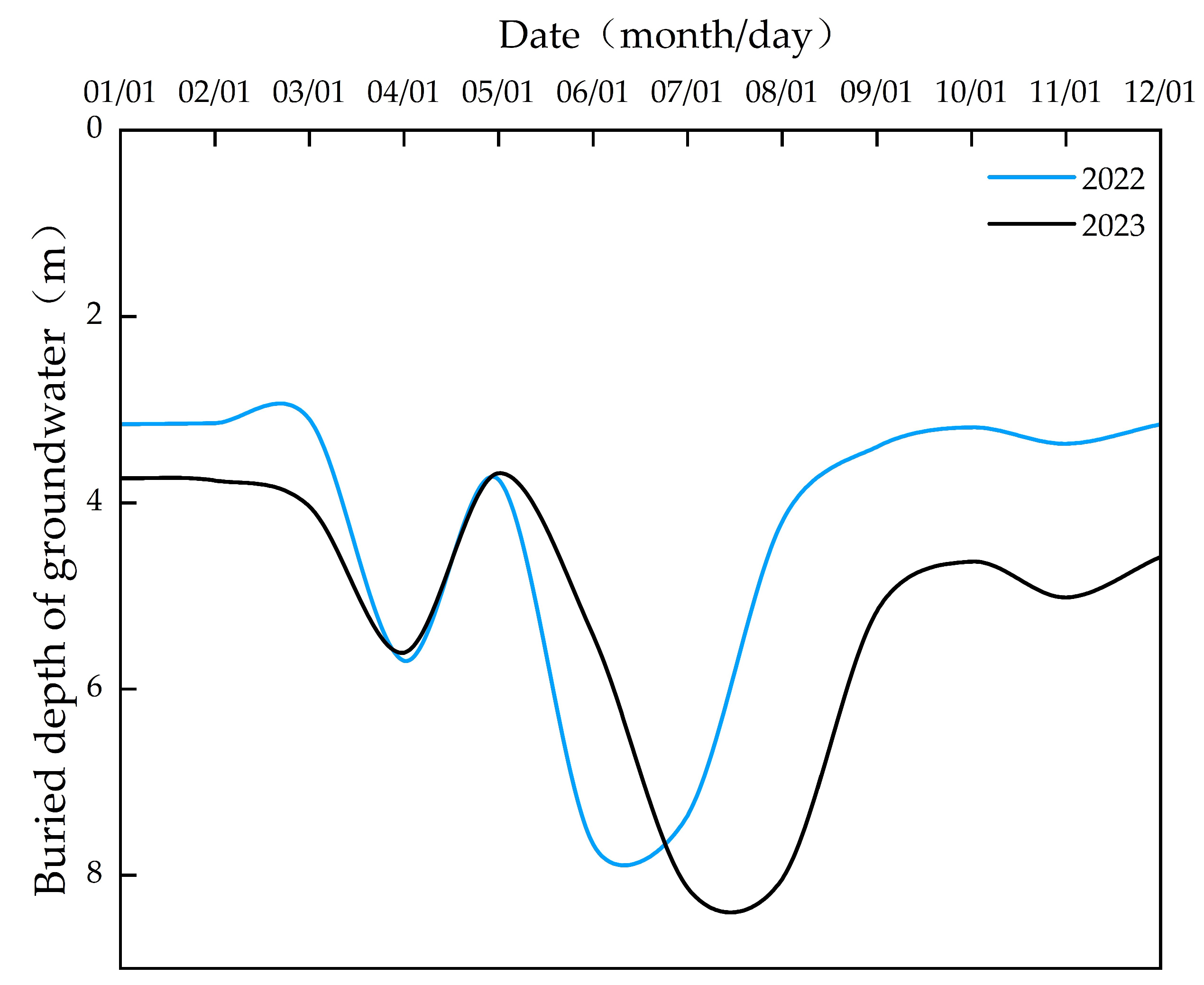
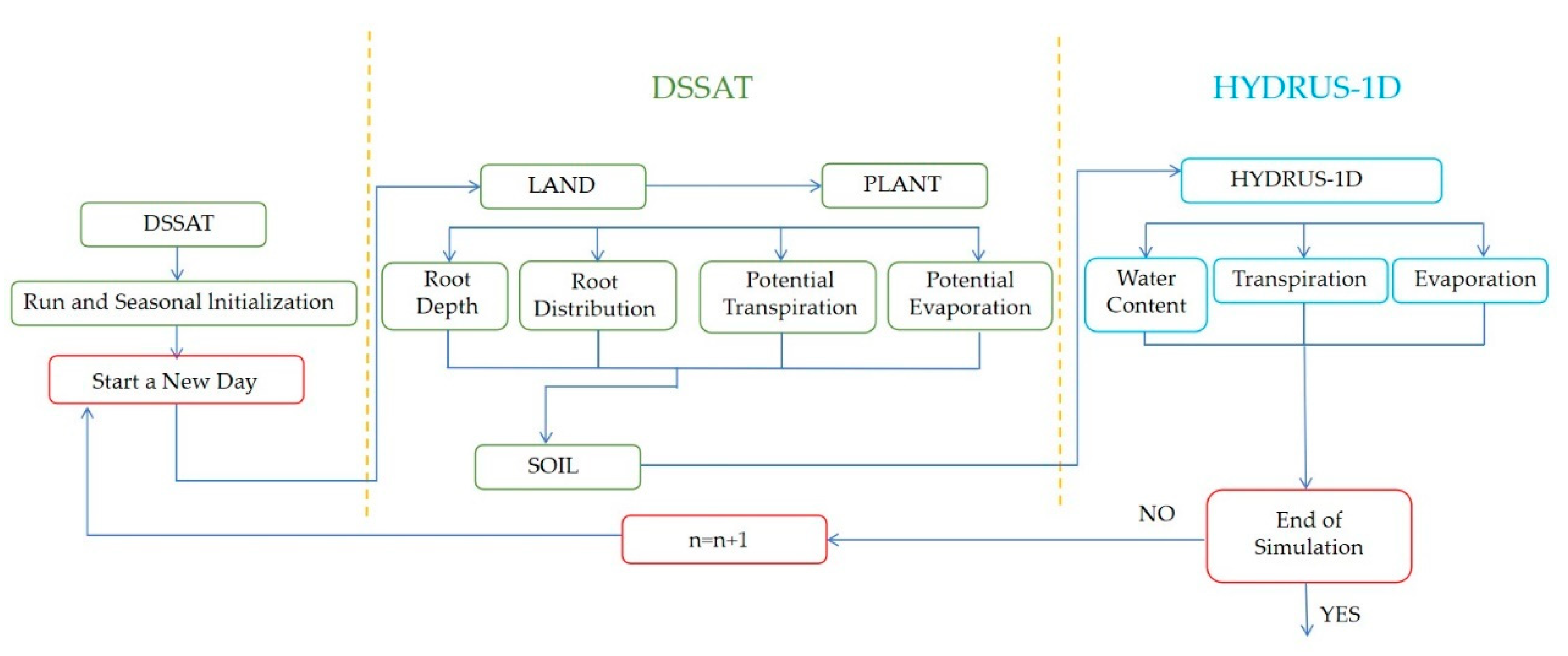
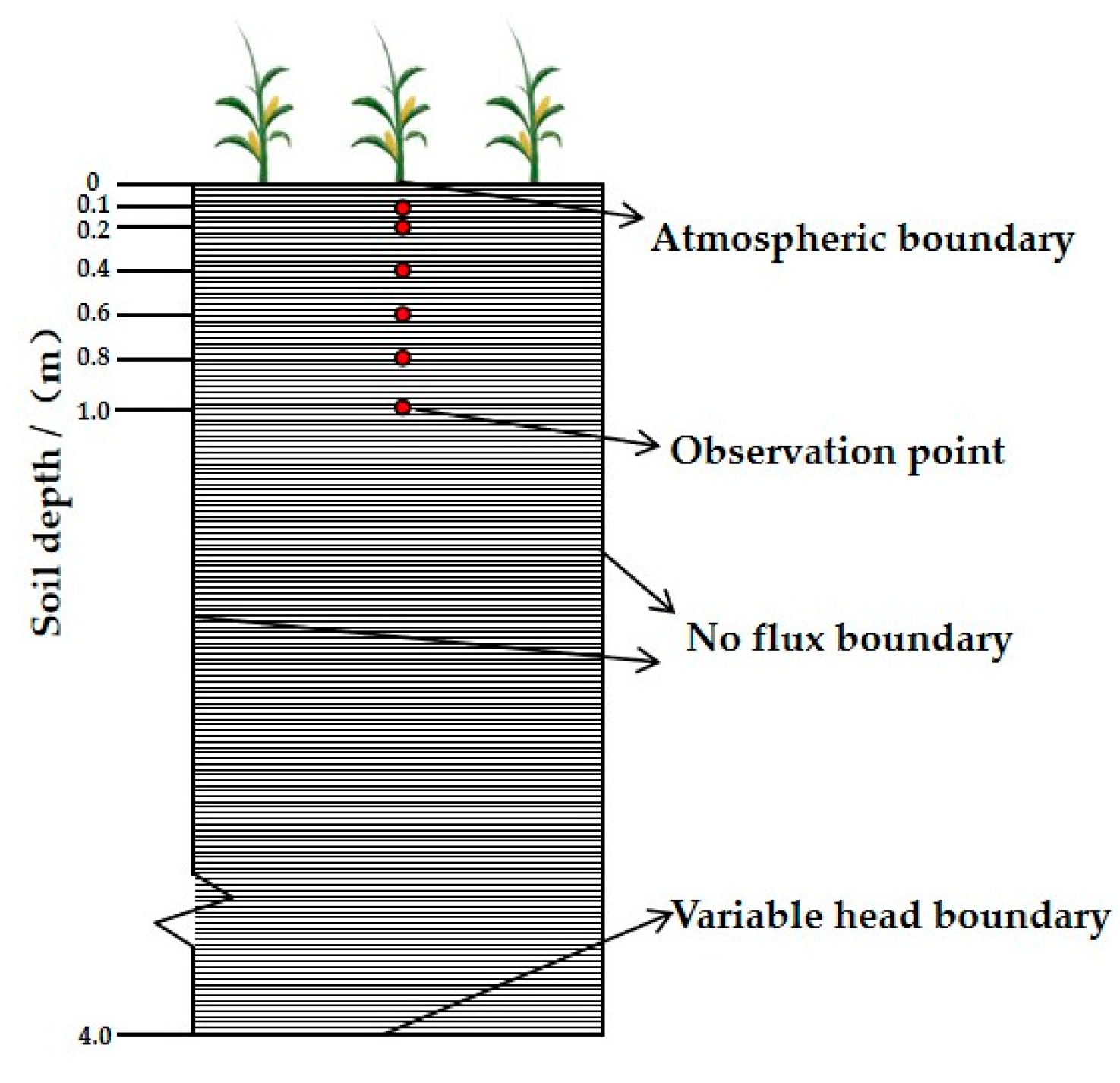


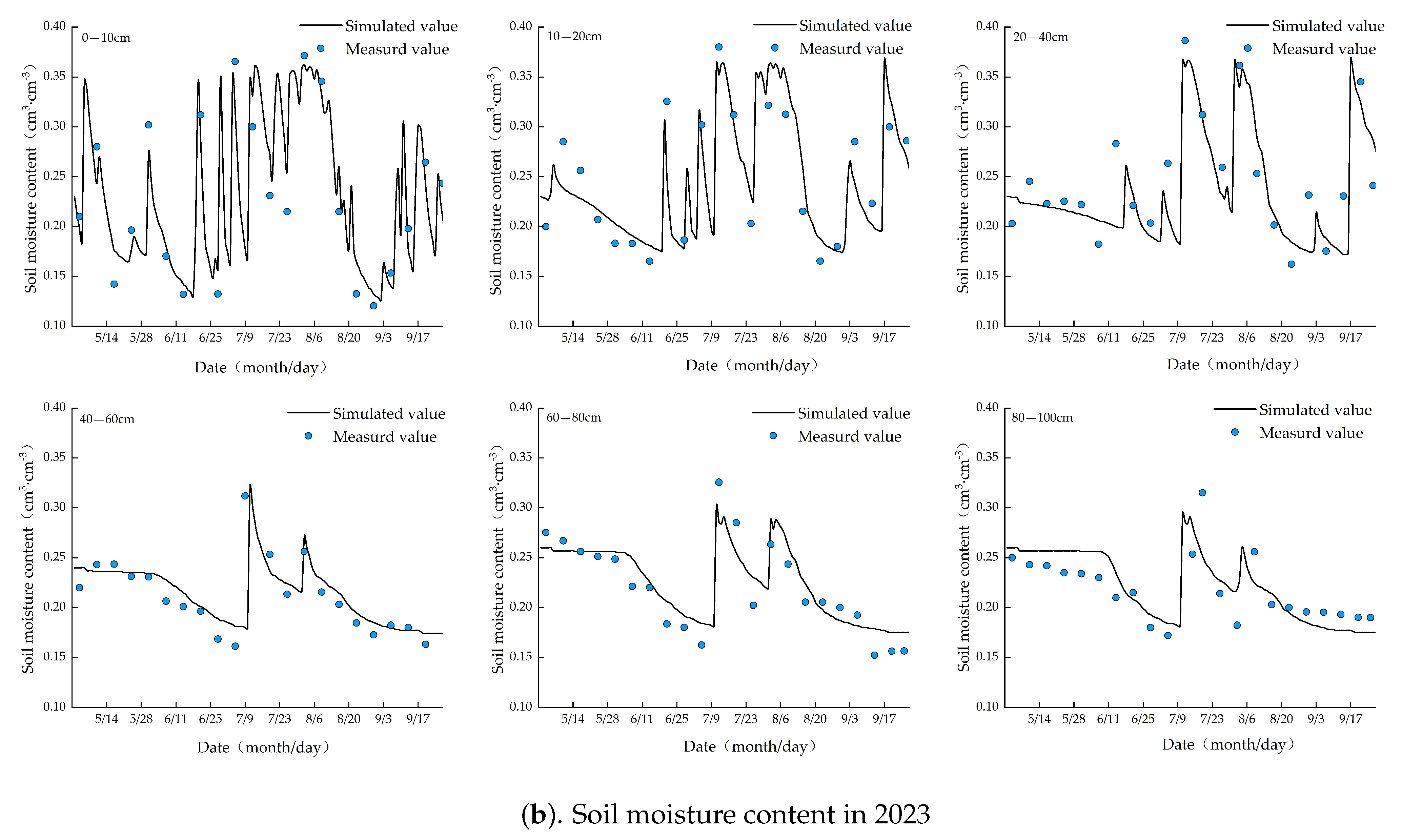
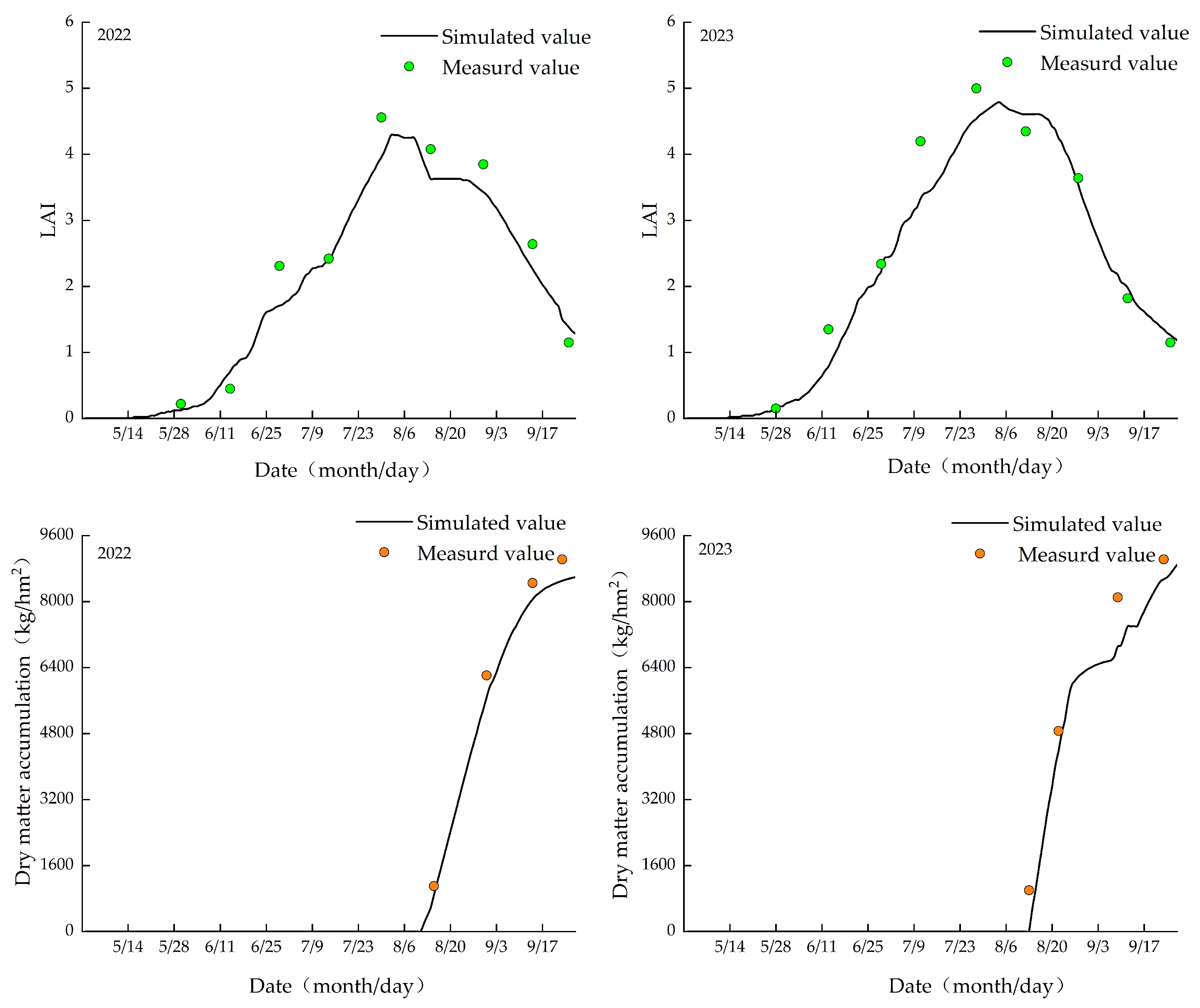
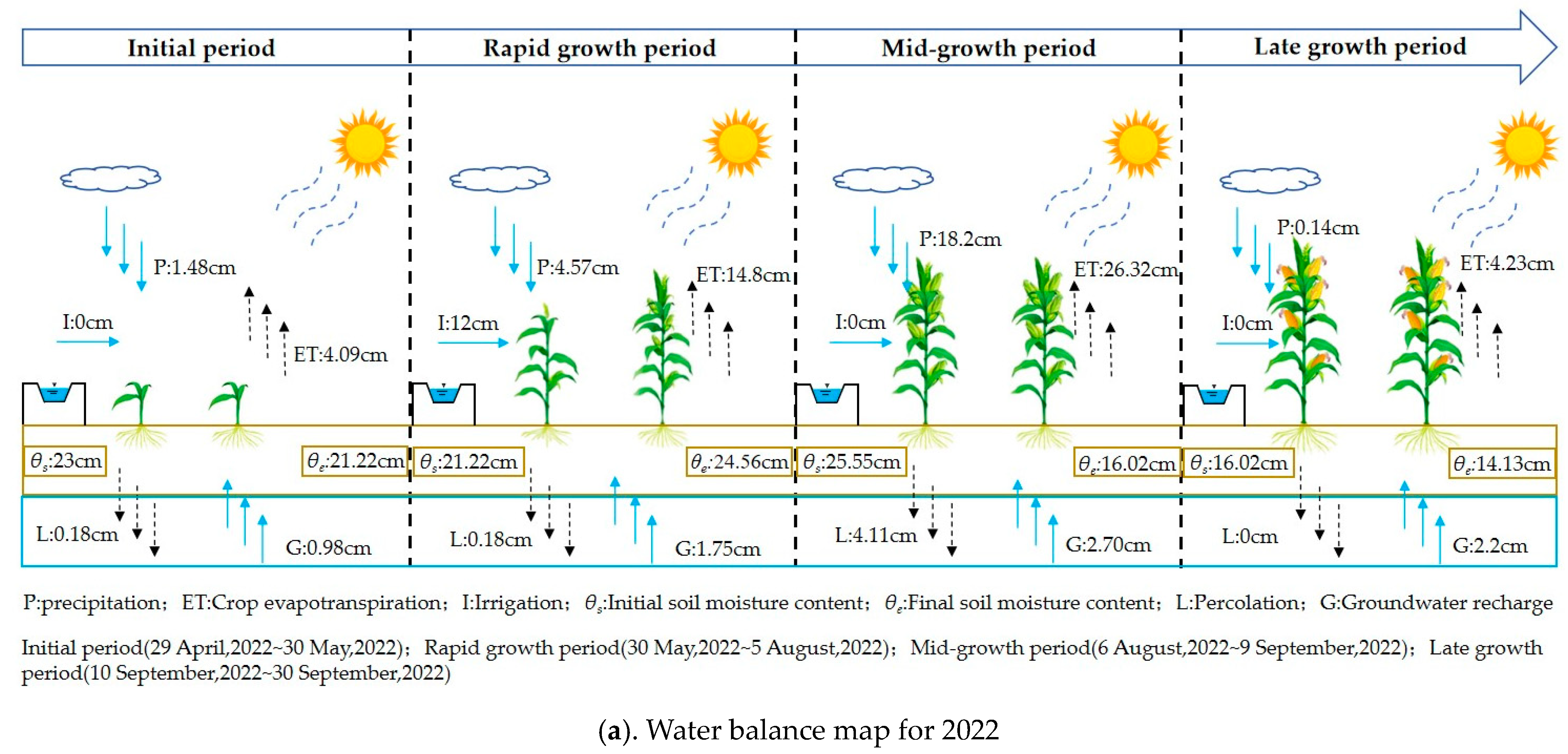
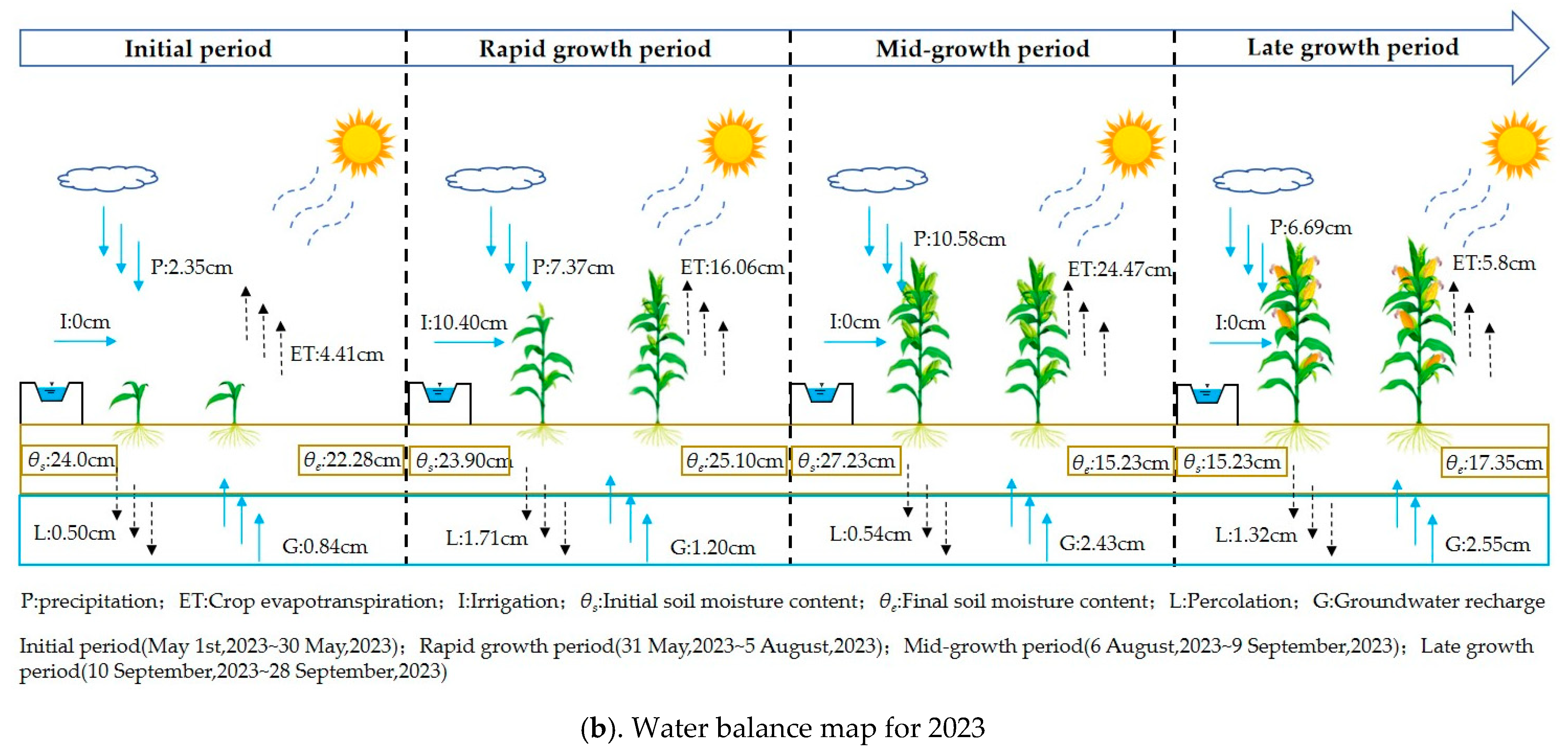
| Soil Depth/cm | Soil Physical Properties | VG Parameters | |||||||
|---|---|---|---|---|---|---|---|---|---|
| 0.02~2 mm | 0.002~0.2 mm | <0.002 mm | Soil Bulk Density/(g·cm−3) | Field Capacity | qr | qs | a/(cm−1) | n | |
| /% | /% | /% | |||||||
| 0–20 | 56.830 | 24.615 | 18.555 | 1.59 | 0.37 | 0.0670 | 0.3862 | 0.0321 | 1.4623 |
| 20–40 | 62.605 | 22.580 | 14.815 | 1.61 | 0.28 | 0.0538 | 0.3914 | 0.0415 | 1.4325 |
| 40–60 | 67.020 | 21.485 | 11.495 | 1.65 | 0.30 | 0.0420 | 0.3831 | 0.0323 | 1.4134 |
| 60–80 | 58.450 | 22.260 | 19.290 | 1.52 | 0.31 | 0.0586 | 0.3889 | 0.0251 | 1.3841 |
| 80–100 | 55.295 | 24.810 | 19.895 | 1.45 | 0.28 | 0.0437 | 0.3823 | 0.0220 | 1.4251 |
| Year | Crop | Planting Time | Growing Period | Days/d | |||
|---|---|---|---|---|---|---|---|
| Initial Period/d | Rapid Growth Period/d | Mid-Growth Period/d | Late Growth Period/d | ||||
| 2022 | Maize | 29 April | 32 | 67 | 35 | 20 | 154 |
| 2023 | Maize | 1 May | 30 | 67 | 35 | 18 | 150 |
| Land Types | Soil Layer/cm | θr | θs | α | n | Ks/(cm·d−1) | l |
|---|---|---|---|---|---|---|---|
| Maize | 0~20 | 0.0670 | 0.3862 | 0.0264 | 1.3782 | 36.82 | 0.5 |
| 20~40 | 0.0538 | 0.3914 | 0.0232 | 1.426 | 58.35 | 0.5 | |
| 40~60 | 0.0420 | 0.3831 | 0.0323 | 1.4134 | 43.62 | 0.5 | |
| 60~80 | 0.0586 | 0.3889 | 0.0237 | 1.3652 | 38.72 | 0.5 | |
| 80~100 | 0.0437 | 0.3823 | 0.0208 | 1.4156 | 60.25 | 0.5 |
| Function | Function/cm | Description | Calibration Values/cm |
|---|---|---|---|
| Water stress function | h1 | No water extraction at higher pressure heads | −12 |
| h2 | h below which optimal water starts | −35 | |
| h3h | h below which water uptake reduction starts at high atmospheric demand | −325 | |
| h3l | h below which water uptake reduction starts at low atmospheric demand | −600 | |
| h4 | h below which water uptake is zero | −8000 | |
| r2H | Threshold level of high atmospheric demand/(cmd−1) | 0.5 | |
| r2L | Threshold level of low atmospheric demand/(cmd−1) | 0.1 |
| Statistical Index | RMSE | R2 | b | MRE/% | |
|---|---|---|---|---|---|
| Model calibration (2022) | Soil moisture content (cm3/cm3) | 0.02 | 0.90 | 1.02 | 5.77 |
| LAI | 0.16 | 0.92 | 0.98 | 8.28 | |
| Yield (kg/hm2) | 1.30 | 0.84 | 0.93 | 2.34 | |
| Model validation (2023) | Soil moisture content (cm3/cm3) | 0.04 | 0.89 | 0.92 | 6.03 |
| LAI | 0.20 | 0.91 | 1.12 | 6.57 | |
| Yield (kg/hm2) | 1.24 | 0.88 | 0.90 | 1.58 |
| Parameter | P1 | P2 | P5 | G2 | G3 | PHINT |
|---|---|---|---|---|---|---|
| Range | 100~400 | 0~4 | 600~1000 | 500~1000 | 5~12 | 30~75 |
| Optimal value | 385.4 | 0.496 | 814.5 | 985.0 | 11.5 | 75.0 |
Disclaimer/Publisher’s Note: The statements, opinions and data contained in all publications are solely those of the individual author(s) and contributor(s) and not of MDPI and/or the editor(s). MDPI and/or the editor(s) disclaim responsibility for any injury to people or property resulting from any ideas, methods, instructions or products referred to in the content. |
© 2024 by the authors. Licensee MDPI, Basel, Switzerland. This article is an open access article distributed under the terms and conditions of the Creative Commons Attribution (CC BY) license (https://creativecommons.org/licenses/by/4.0/).
Share and Cite
Zhou, J.; Tian, D.; Shi, H.; Xu, B.; Zheng, Z.; Wang, F.; Wang, G.; Miao, X. Coupled DSSAT and HYDRUS-1D Simulation of the Farmland–Crop Water Cycling Process in the Dengkouyangshui Irrigation District. Water 2024, 16, 1049. https://doi.org/10.3390/w16071049
Zhou J, Tian D, Shi H, Xu B, Zheng Z, Wang F, Wang G, Miao X. Coupled DSSAT and HYDRUS-1D Simulation of the Farmland–Crop Water Cycling Process in the Dengkouyangshui Irrigation District. Water. 2024; 16(7):1049. https://doi.org/10.3390/w16071049
Chicago/Turabian StyleZhou, Jie, Delong Tian, Haibin Shi, Bing Xu, Zhonghou Zheng, Fan Wang, Guoshuai Wang, and Xiangyang Miao. 2024. "Coupled DSSAT and HYDRUS-1D Simulation of the Farmland–Crop Water Cycling Process in the Dengkouyangshui Irrigation District" Water 16, no. 7: 1049. https://doi.org/10.3390/w16071049
APA StyleZhou, J., Tian, D., Shi, H., Xu, B., Zheng, Z., Wang, F., Wang, G., & Miao, X. (2024). Coupled DSSAT and HYDRUS-1D Simulation of the Farmland–Crop Water Cycling Process in the Dengkouyangshui Irrigation District. Water, 16(7), 1049. https://doi.org/10.3390/w16071049






